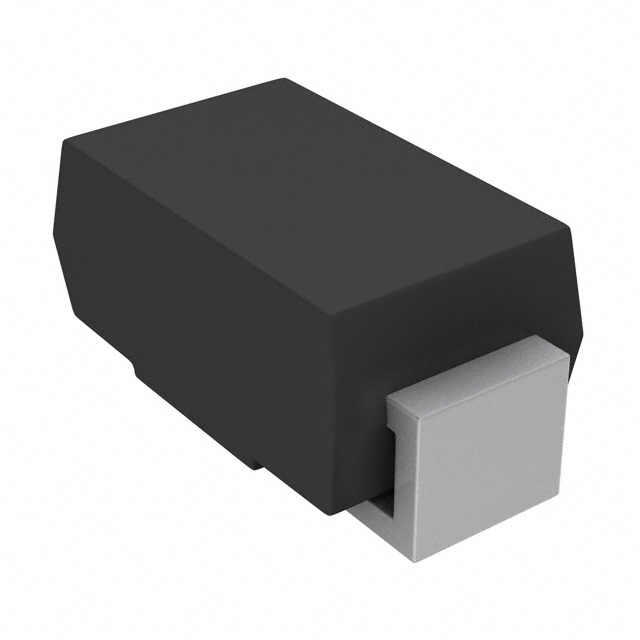Viz Specifikace pro podrobnosti o produktu.

S1J-E3/51T
Product Overview
The S1J-E3/51T belongs to the category of rectifier diodes and is commonly used in electronic circuits for converting alternating current (AC) to direct current (DC). These diodes are known for their high efficiency, low power loss, and compact package size. The S1J-E3/51T is typically available in a variety of packaging options and quantities, making it suitable for a wide range of applications.
Basic Information
- Category: Rectifier Diodes
- Use: Converting AC to DC
- Characteristics: High efficiency, low power loss
- Package: Various options available
- Essence: Efficient conversion of AC to DC
- Packaging/Quantity: Available in different packaging and quantities
Specifications
- Voltage Rating: 600V
- Current Rating: 1A
- Package Type: DO-214AC (SMA)
Detailed Pin Configuration
The S1J-E3/51T has a standard DO-214AC (SMA) package with two pins. Pin 1 is the anode, and pin 2 is the cathode.
Functional Features
- Efficient rectification of AC to DC
- Low forward voltage drop
- High surge current capability
- Compact and space-saving design
Advantages and Disadvantages
Advantages
- High efficiency
- Low power loss
- Compact package size
- High surge current capability
Disadvantages
- Limited maximum current rating
- Voltage limitations may not be suitable for high-power applications
Working Principles
The S1J-E3/51T operates based on the principle of semiconductor rectification. When an AC voltage is applied, the diode allows current flow in one direction, effectively converting the input AC signal into a pulsating DC output.
Detailed Application Field Plans
The S1J-E3/51T is widely used in various electronic devices and equipment, including: - Power supplies - Battery chargers - LED lighting systems - Consumer electronics
Detailed and Complete Alternative Models
Some alternative models to the S1J-E3/51T include: - 1N4007: A general-purpose rectifier diode with higher current and voltage ratings - 1N5819: Schottky diode with lower forward voltage drop - FR107: Fast recovery diode suitable for high-frequency applications
In conclusion, the S1J-E3/51T rectifier diode offers high efficiency and compact design, making it suitable for a wide range of applications in electronic circuits. While it has certain limitations in terms of current and voltage ratings, it remains a popular choice for many low to medium power applications.
Word Count: 366
Seznam 10 běžných otázek a odpovědí souvisejících s aplikací S1J-E3/51T v technických řešeních
What is the S1J-E3/51T?
- The S1J-E3/51T is a high-speed switching diode designed for general-purpose applications.
What are the key features of the S1J-E3/51T?
- The key features of the S1J-E3/51T include its high-speed switching capability, low forward voltage drop, and high reliability.
What are the typical applications of the S1J-E3/51T?
- The S1J-E3/51T is commonly used in rectification, freewheeling, and polarity protection applications in various electronic circuits.
What is the maximum forward voltage of the S1J-E3/51T?
- The maximum forward voltage of the S1J-E3/51T is typically around 1V at a forward current of 1A.
What is the reverse recovery time of the S1J-E3/51T?
- The reverse recovery time of the S1J-E3/51T is typically in the range of nanoseconds, making it suitable for high-speed switching applications.
Is the S1J-E3/51T suitable for high-frequency applications?
- Yes, the S1J-E3/51T is suitable for high-frequency applications due to its fast switching characteristics.
What is the maximum reverse voltage rating of the S1J-E3/51T?
- The S1J-E3/51T typically has a maximum reverse voltage rating of around 600V.
Does the S1J-E3/51T require a heatsink for operation?
- For most typical applications, the S1J-E3/51T does not require a heatsink due to its low power dissipation.
Can the S1J-E3/51T be used in automotive electronics?
- Yes, the S1J-E3/51T is suitable for use in automotive electronics, such as in battery charging and power supply circuits.
Are there any specific soldering or handling precautions for the S1J-E3/51T?
- It is recommended to follow standard ESD (electrostatic discharge) precautions and proper soldering techniques when handling the S1J-E3/51T to ensure its reliability and performance.

